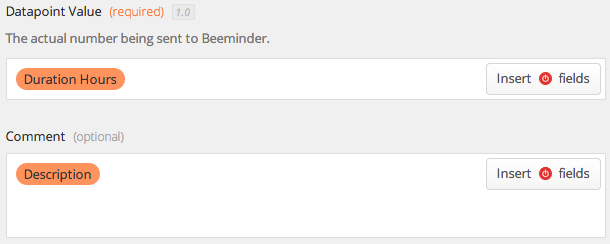
We’re beaming with pride at being the latest official Zapier integration. See also Zapier’s announcement. This is arguably our biggest announcement since the Beeminder API two years ago. It’s a giant leap forward for automatically minding data about yourself!
UPDATE 2018: Zapier has grown to over 1000 integrations!
UPDATE 2023: The so-called “yellow brick road” referenced below is what we now call the
Bright Red Line.
In case you don’t already know about Zapier, it’s a more powerful version of IFTTT. [1] If that didn’t help, then try this: Zapier is a way to get disparate apps to talk to each other. Define an event in one app as a trigger and define a corresponding action in another app. We use Zapier, for example, to cause tweets mentioning Beeminder to show up in our Hipchat. It’s brilliant and powerful and we’re exceedingly proud to announce that Beeminder is now officially integrated with Zapier.
This is an especially big deal for Beeminder because it opens up a world of new autodata sources for beeminding.
Beeminder Reprise
For those just tuning in, Beeminder is a Quantified Self tool for tracking your progress toward goals.
Well, that’s half of it.
The other half is that we let you hard-commit to staying on track toward those goals, by pledging actual money.
We make pretty (nerdy) graphs, plotting your progress along a Yellow Brick Road.
If you stay on track from the start then you’ll never pay anything for Beeminder, or even have to put in a credit card.
[UPDATE: Silly past-us, it’s definitely important to put in a payment method before you derail.
We now call this the
Commitwall.]
But the first time you go off track is when you’ll have to put your money where your mouth is if you want to keep beeminding.
So automatic sources of data are a big deal, both for removing the friction of tracking, and for adding friction for cheating.
There are still plenty of ways to cheat of course, and people first encountering Beeminder often focus on that.
Why would you possibly be willing to pay some company because you screwed up on your goal, they ask.
Well, long-time Beeminder users tell us that the monetary stings (get it?) are well worth it for all the awesomeness we induce the rest of the time.
But if the thought of having to pay money is too scary, that’s perfect: you’ll be very motivated to keep all your datapoints on your yellow brick road.
Again, we don’t even do ask for a credit card until before the first time you go off track.
(The other reason we see surprisingly little cheating on Beeminder is that the whole concept holds no appeal in the first place if you’re the cheating type.
Hooray
self-selection!)
Triggers and Actions
“Maybe you want to do more writing and you save your drafts in a Dropbox folder”
So far the Zapier/Beeminder integration works in one direction: define triggers from other apps that cause an action on Beeminder. The action on Beeminder is always the same: add a datapoint to a graph. The triggers can be anything: Adding hours in Toggl or Harvest, adding tasks in Todoist, adding new files in Dropbox.
The Dropbox example is particularly powerful and general since “adding a new file in Dropbox” can mean so many different things. Maybe you want to beemind how many pictures you take and you have pictures automatically uploading to Dropbox. Or maybe you want to do more writing and you save your drafts in a Dropbox folder. Zapier lets you filter by directory, filename, file attributes (like size and type), you name it. And you can beemind either number of files or total number of bytes. So many possibilities!
Zapminder! Setting Up Zaps to Feed the Bee
To get started creating a zap, pick the trigger app and what event in that app should trigger a new datapoint. The action is Beeminder and “Add Datapoint” is the only action. It looks like this:

Then you give Zapier permission to see your data in the app (Toggl in this example) and similarly for Beeminder. Then you choose what data gets sent to Beeminder, like this:

For many kinds of zapminding the datapoint value will simply be “1”. Like if you completed a task on Todoist then every time that event triggers you’re sending a +1 to Beeminder.
Zapminding Down to the Wire
Beeminder’s all about setting a bright line in the sand. There’s a hard deadline by which you must finish what you said you would. Zapier syncs every 5 or 15 minutes (depending on if you have a paid plan). Either way, that can be a problem if you’re working up to the literal last minute. One answer is, don’t do that! If you make sure to do the bare minimum Beeminder specifies by 15 minutes before the deadline, you should be fine. But hardcore Beeminder users often find themselves down to the wire. If that’s you, you can force a sync from Zapier to make sure you’re safely on Beeminder’s yellow brick road before the deadline.
Do that by clicking the red Zapier icon above your graph:
![]()
That will take you to your Zapier dashboard where you can force the zap to run like so:

We’re working on a way to automatically trigger a sync from Zapier right at your deadline. (We may also work around the problem by adding a grace period where data from Zapier that’s up to 15 minutes late still counts as under the wire.) As soon as we do then Zapier-mediated beeminding will be every bit as good as our official integrations. For all but the most extreme procrastinators it already is!
So, dive in, and let us know what zaps you create! Here are a few you can start with:
Thanks to Lee Greenwood for implementing the initial prototype of our Zapier integration.